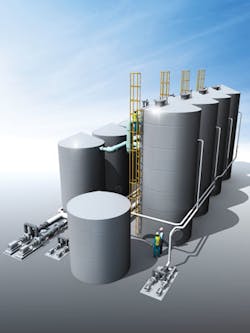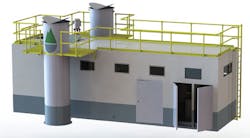By Jeff Gunderson
On September 30, the U.S. Environmental Protection Agency (EPA) released a final rule that revises the Effluent Limit Guidelines (ELGs) for the steam electric power generating category, establishing limits on the levels of toxic metals in wastewater that can be discharged from power plants. The new guidelines are based on technology improvements in the stream electric power industry over the last 30 years, and specifically, the widespread adoption of air pollution controls in many power plants that have either altered existing wastewater streams or created new ones.
Based on EPA estimates, the rule is projected to reduce the annual amount of toxic metals, nutrients, and other pollutants that steam electric power plants are allowed to discharge by 1.4 billion pounds and reduce water withdrawals by 57 billion gallons. Estimated annual compliance costs for the final rule are $480 million and the anticipated benefits between $451 and $566 million.
Direct discharge limitations in the new rule will be enforced through National Pollutant Discharge Elimination System (NPDES) permits. As power plants renew these permits (which expire at five-year intervals), the permitting authority is responsible for determining the date by which plants must meet the new, more stringent effluent limitations. For direct dischargers, this date must be “as soon as possible” beginning November 1, 2018, but in no case later than December 31, 2023.
“The EPA provided this additional time to comply so that plants can comprehensively consider the process changes and new equipment installations that would be required to meet the new requirements,” an EPA spokesman said. “This approach also provides the time that many facilities need to raise capital, plan and design systems, procure equipment, and construct and then test systems.”
Bill Heins, general manager of thermal products at GE Water & Process Technologies (GEWPT), said roughly 12 percent of the existing 1,100 power plants are facing modifications in order to accommodate new treatment systems. “It’s going to take a fair amount of time to conduct feasibility studies, water balances, and determine the right approach for each particular plant,” he said.
According to Heins, his team has been anticipating what the final rule would look for quite some time, including the technological implications for complying.
“We’ve been working on designing technologies that would address specific steam electric power plant discharges and adhere to requirements in connection with the new ruling,” Heins said. “Now that the rule is out, we are ready to start working in detail with our customers to develop customized solutions.”
Since so many variables can come into play when addressing these high-salinity process wastewaters, Heins said treatment solutions cannot be narrowly focused, but rather must be flexible to handle a range of conditions.
“Different regions can have different source waters and distinct types of coal, which influences the water chemistry and the produced waste streams,” Heins explained. “These conditions are also prone to change, so solutions needs to be adaptable.”
The point of discharge is another factor to consider, he said. “For example, specific standards could be in place if effluent is being discharged to a waterway that eventually feeds a drinking water source,” Heins said.
While EPA’s rule does not require power plants to use any specific technology to comply, the new ELGs were developed based on the performance of what EPA determined was the best available technology (BAT) for treating each specific process wastewater stream. These BATs include chemical and biological treatment, evaporation, and others such as precipitation and softening.
Renewed Focus on Metals and Dissolved Pollutants
In contrast to the previous 1982 rule - which focused on settling out particulates - the new rule is geared towards toxic metal discharges, including nutrients and other dissolved pollutants. According to the EPA spokesman, the electric power industry has made great strides to address air pollutant emissions under Clean Air Act programs, yet many of these pollutants are transferred to the wastewater as plants employ technologies to reduce air pollution.
For existing steam electric power plants that are 50 megawatts (MW) and higher, the new ELGs require zero liquid discharge (ZLD) of all pollutants for fly ash transport water, bottom ash transport water and flue gas mercury control (FGMC) wastewater. Additionally, the new rule establishes effluent limitation standards for arsenic, mercury, selenium, and nitrate-nitrite as N in flue gas desulfurization (FGD) wastewater and for arsenic, mercury, selenium, and total dissolved solids (TDS) in gasification wastewater.
Technologies and Solutions
New and advanced treatment technologies and solutions are available on the market for adhering to requirements specified in the new technology-based ELGs.
GEWPT’s advanced biological metals (ABMet) removal system, which enables for effective nitrate removal and mercury and arsenic polishing, provides end users with a BAT designed for treating FGD purge streams. The fully automated system captures and removes selenium directly within a biological reactor, eliminating the need to transform and transfer selenium to downstream processes for removal.
GEWPT also provides evaporation/solidification technology for plants that wish to recover and reuse 100 percent of FGD waste streams and eliminate liquid discharge from their plant.
“As an incentive - since evaporation/solidification technology may require higher capital costs - plants that want to pursue this option have until 2023 to comply with the regulations,” Heins said.
Over the last few years, GEWPT has further refined its evaporation/solidification technology in order to reduce capital and operating costs and also to minimize the environmental risks associated with residual treated solids that are sent to landfills, according to Heins.
“We developed a pozzolanic chemistry solidification technology that produces a solidified material instead of crystallized salts,” he said. “This end product resists leaching and exhibits high compressible strength, which helps alleviate long-term liabilities associated with landfill management. In fact, it can actually be driven on.”
Frontier Water Systems, which fabricates skid-mounted bioreactor systems for treating mining industry wastewaters, recently developed a new modular system for addressing steam electric power process wastewaters and enabling plants to meet the EPA’s new ELGs. The packaged solution, called the SeHAWK™ bioreactor system, integrates physical and chemical pretreatment with advanced biological post-treatment and is designed to provide effective removal of pollutants and metals such as selenium, nitrate, mercury and arsenic.
Frontier Water cofounder and CTO Tim Pickett said the new bioreactor configuration was engineered from the ground up and includes integrated filtration for fine particulate removal, which will help address pollutants such as mercury and colloidal selenium particulates.
“The Frontier SeHAWK system is built around a new fluidized bed bioreactor technology, with optimization of nutrient delivery, microbiology, and virtually every other system component that we could improve,” Pickett said. “Based on these incremental advancements, we were able to develop a much smaller system. The new modular bioreactor is relocatable and includes a more compact footprint with less infrastructure, lowering construction costs.”
Another distinct advantage includes the system’s non-metallic design, according to Pickett. “In power generation, one of the specific challenges is treating FGD blowdown, a primary waste stream with high salt content and total dissolved solids which presents corrosion issues,” he said. “With the SeHAWK system, we can specify fiberglass, plastics or rubber-lined pumps and components - it’s just a matter of selecting the right option that is best compatible with the water. By including non-metallic wetted surfaces, we are effectively removing corrosion from the equation.”
About the Author: Jeff Gunderson is a correspondent for Industrial WaterWorld. He is a professional writer with over 10 years of experience, specializing in areas connected to water, environment and building, including wastewater, stormwater, infrastructure, natural resources, and sustainable design. He holds a master’s degree in environmental science and engineering from the Colorado School of Mines and a bachelor’s degree in general science from the University of Oregon.




